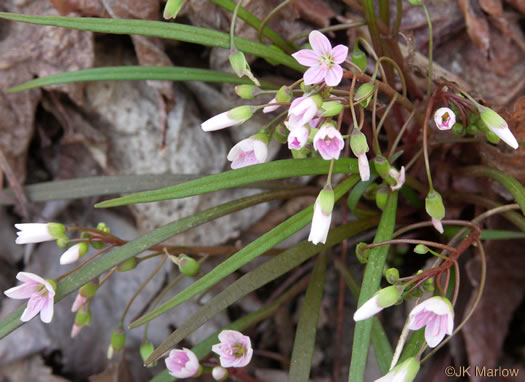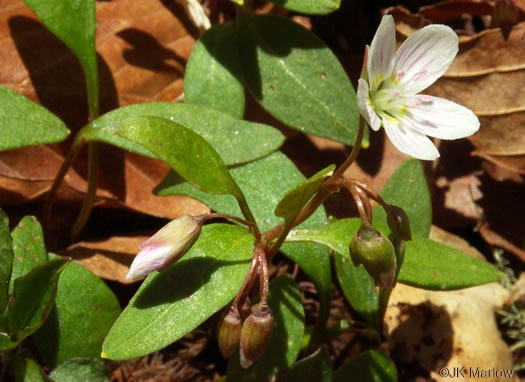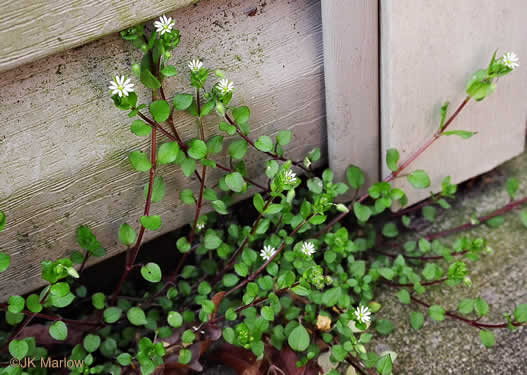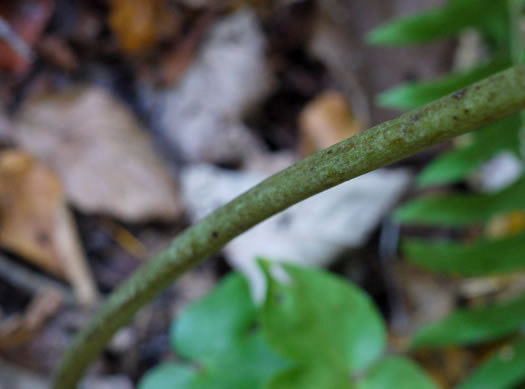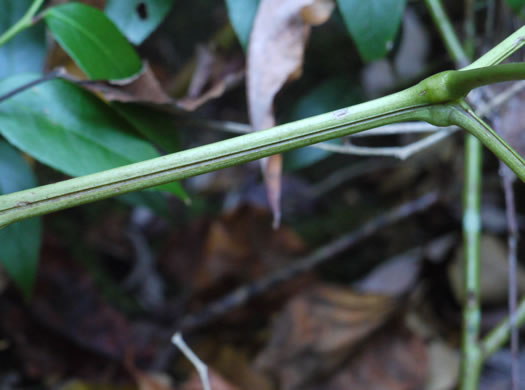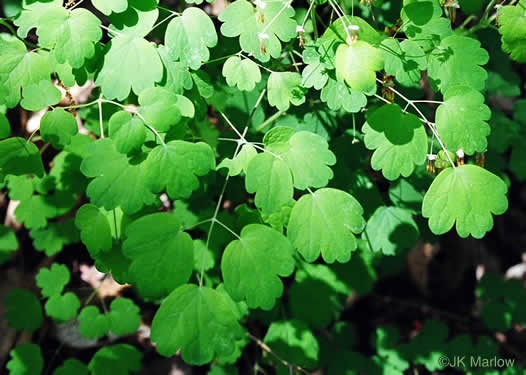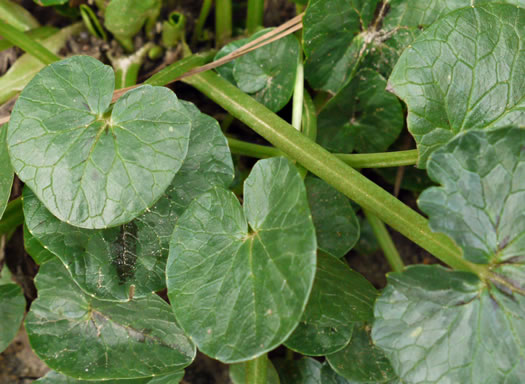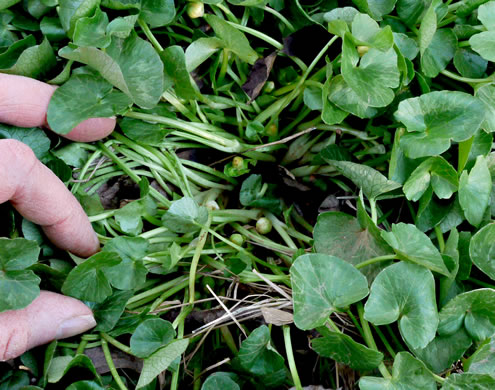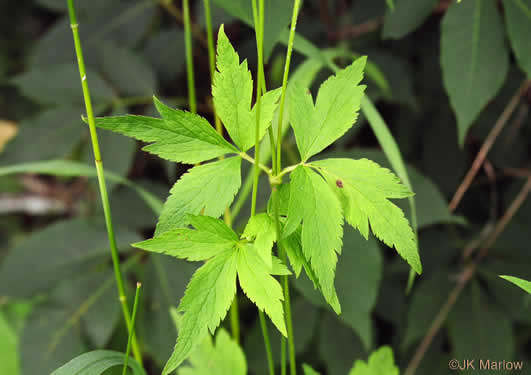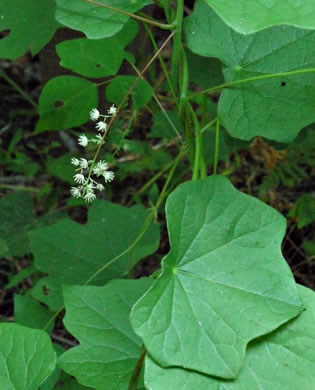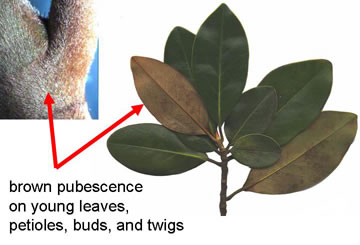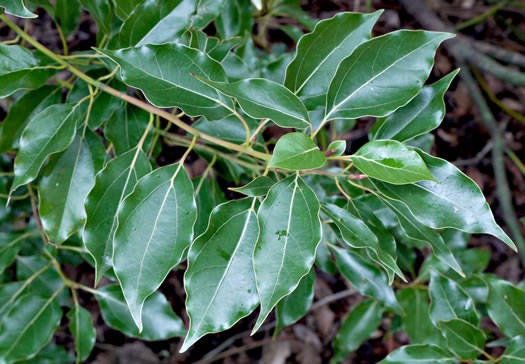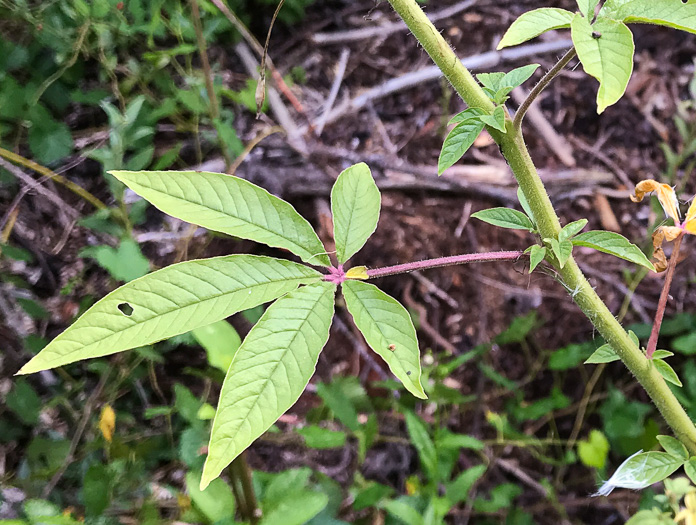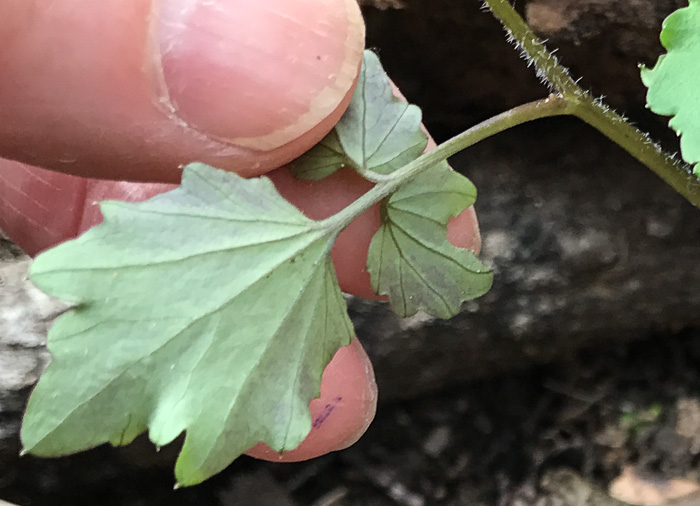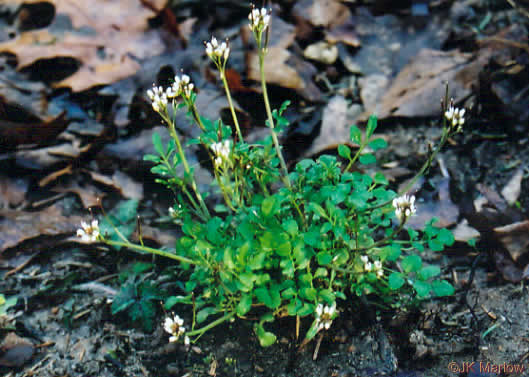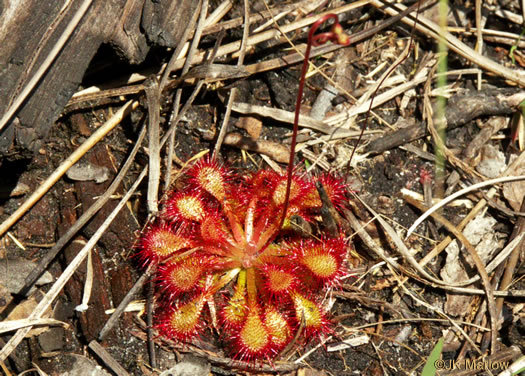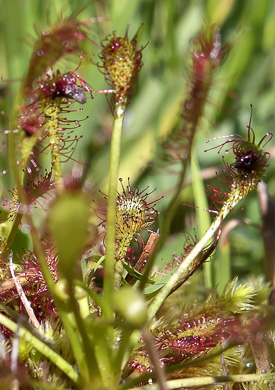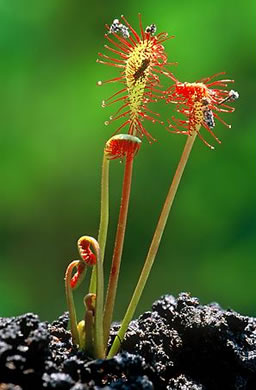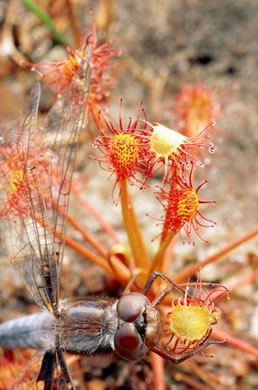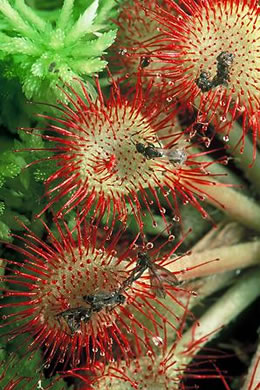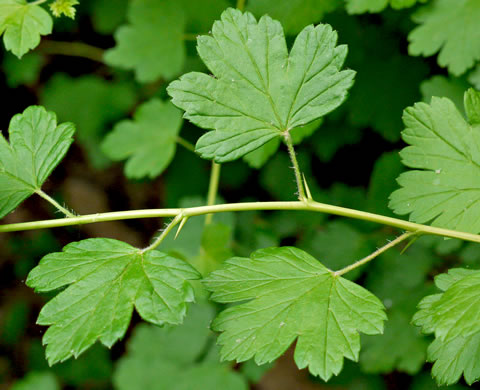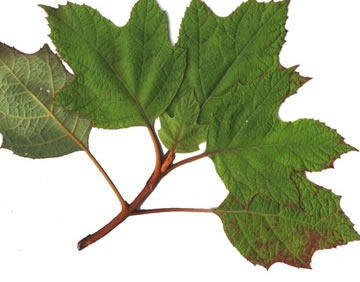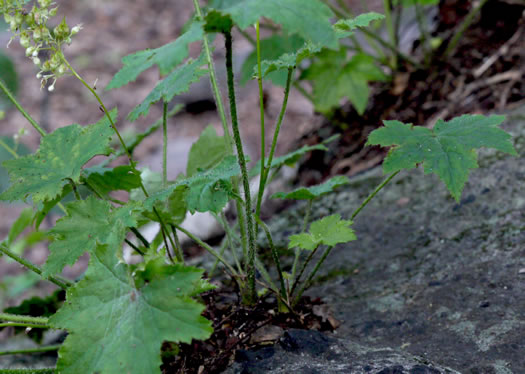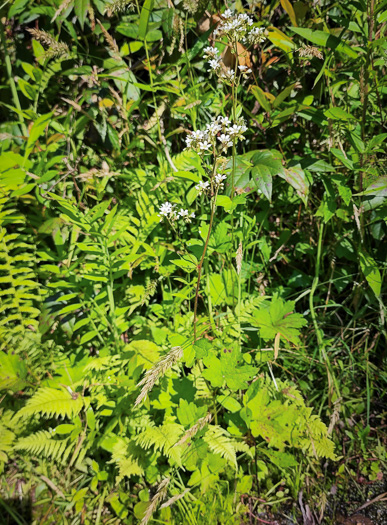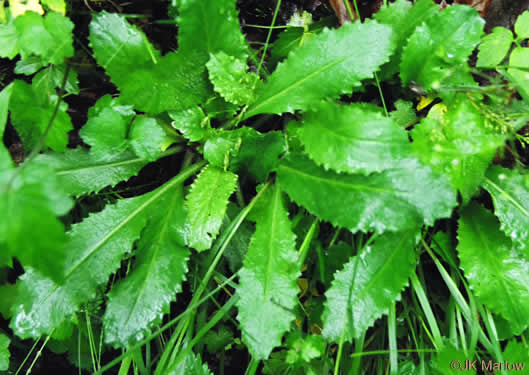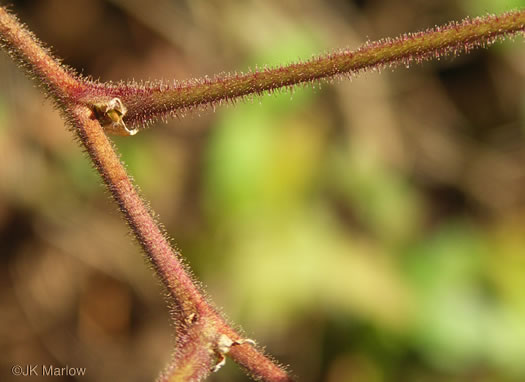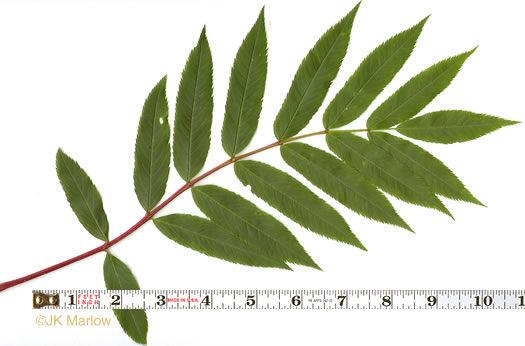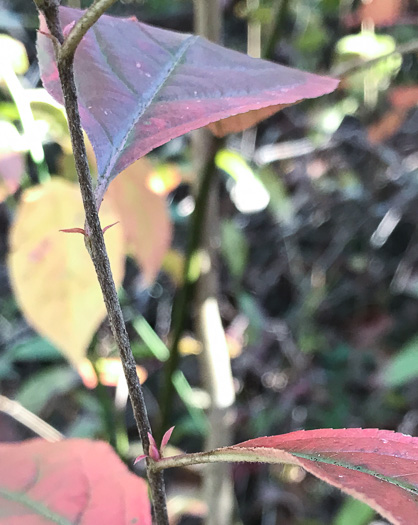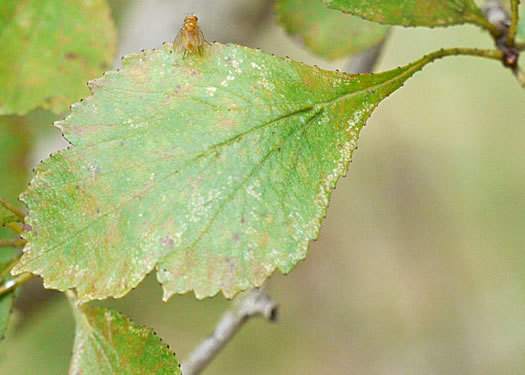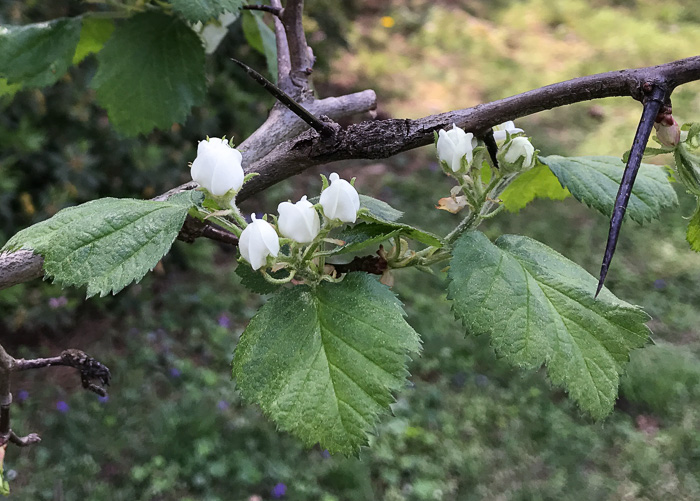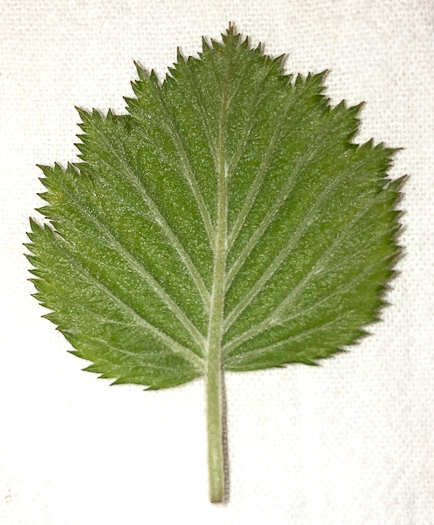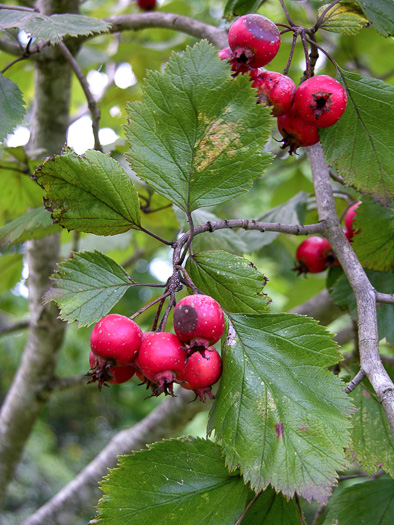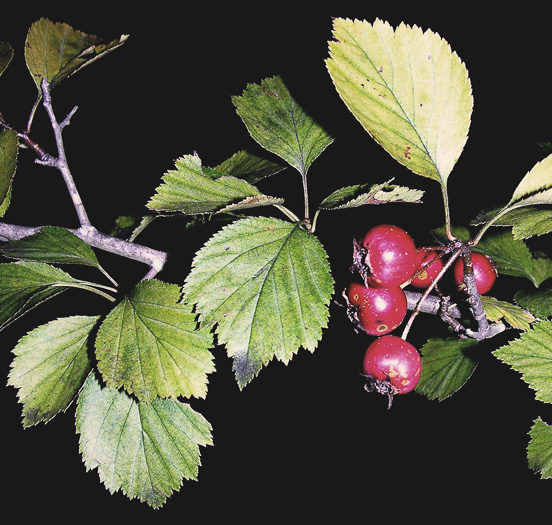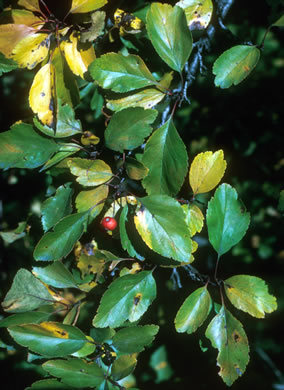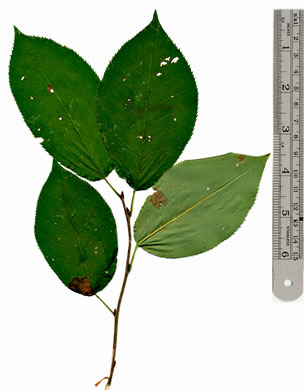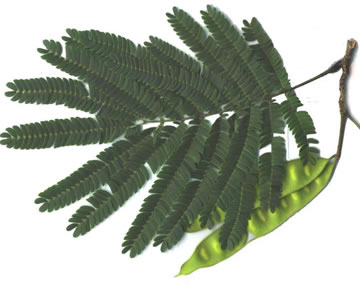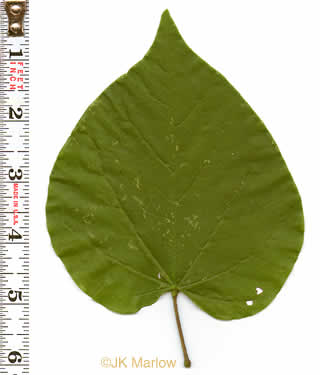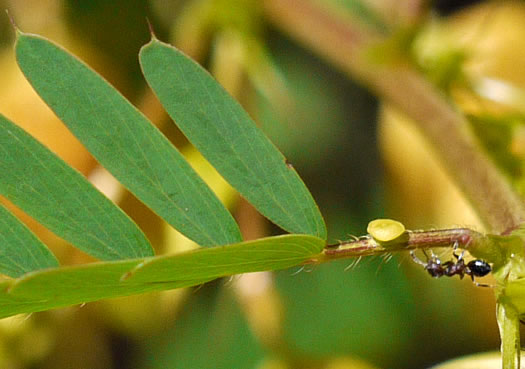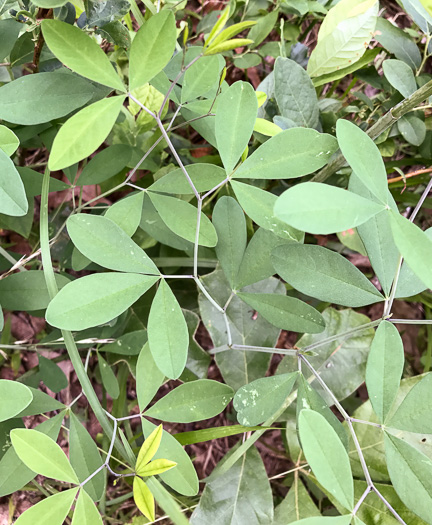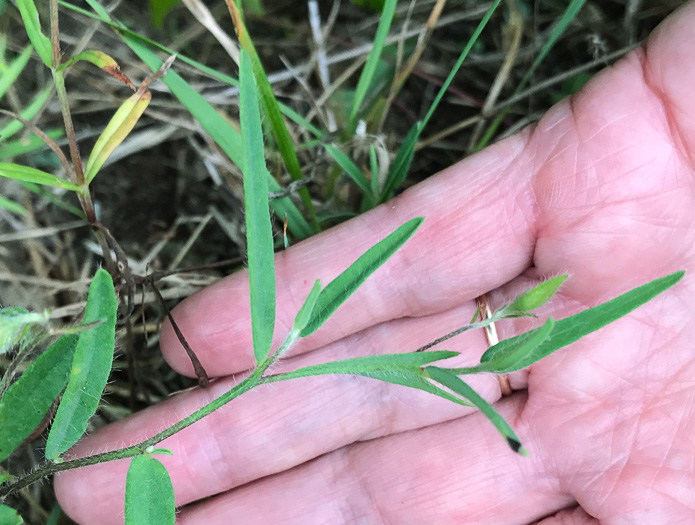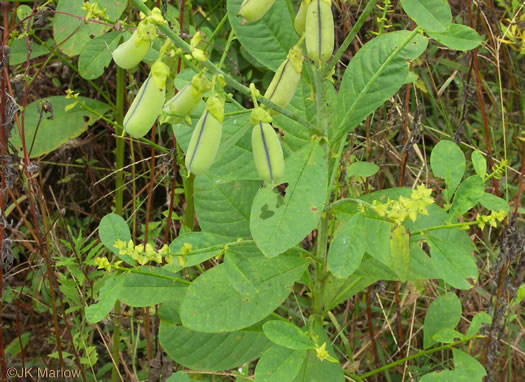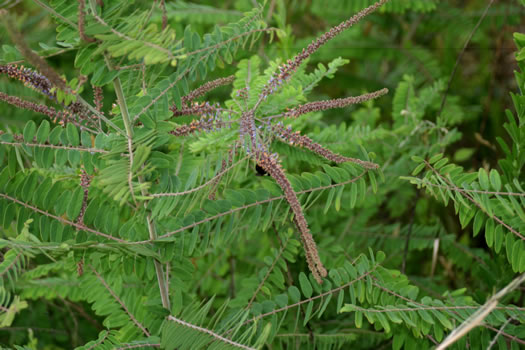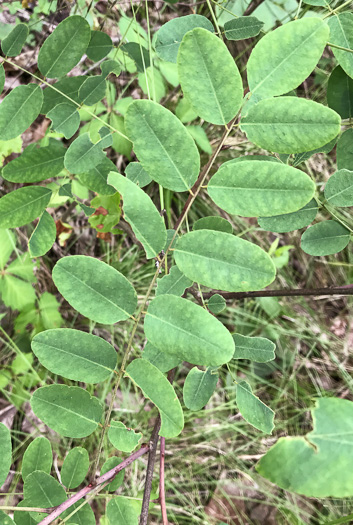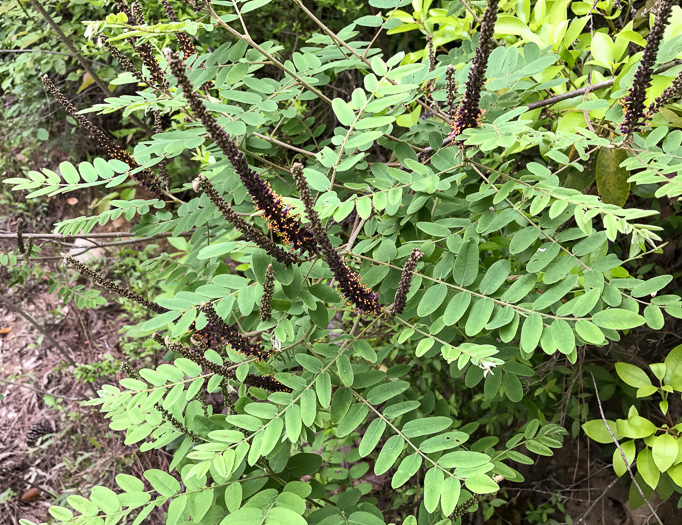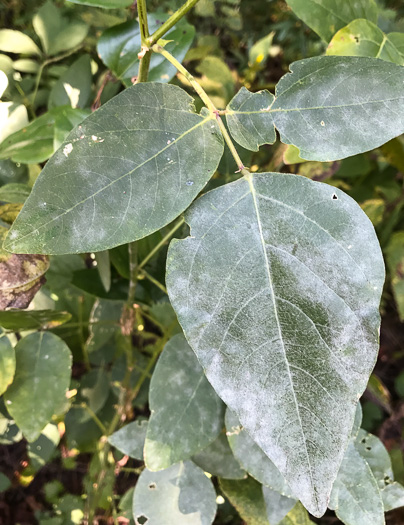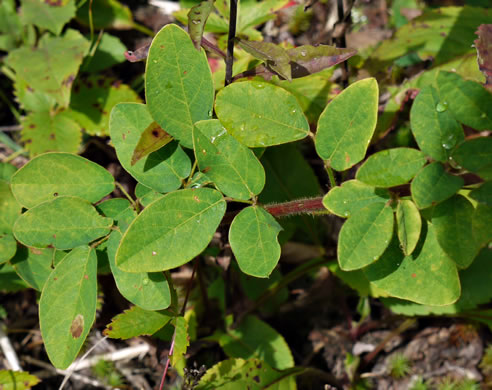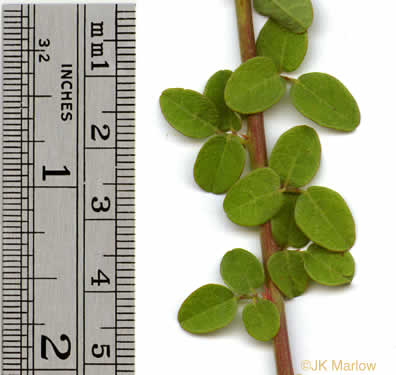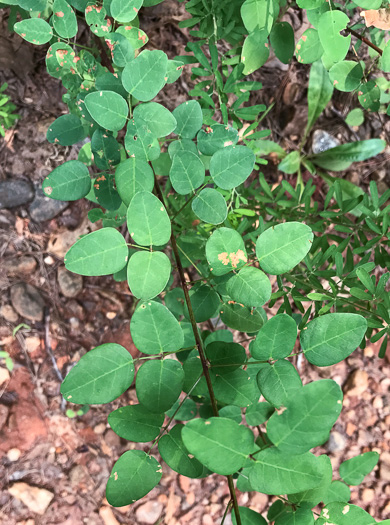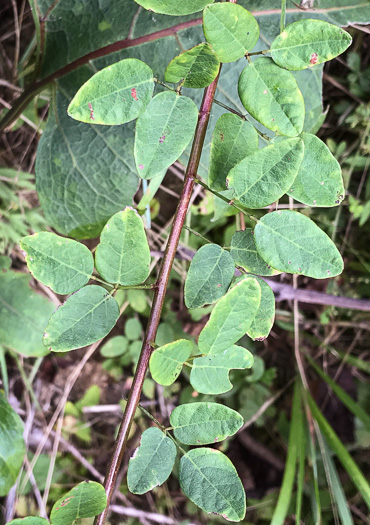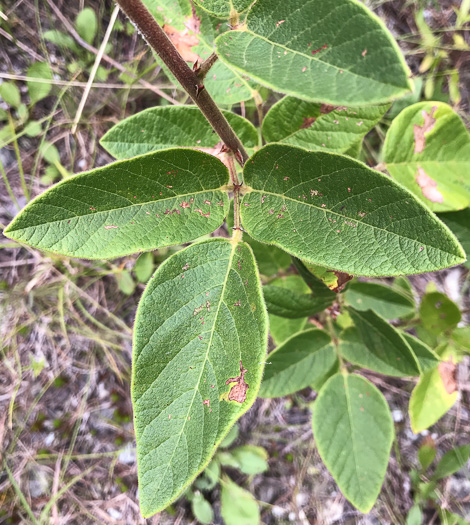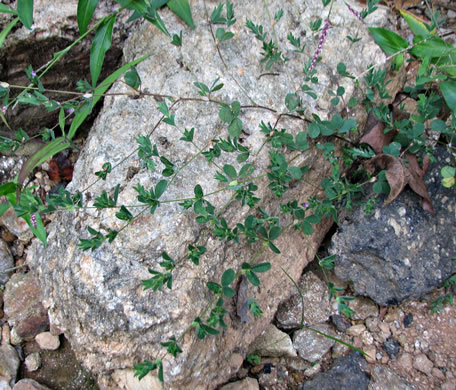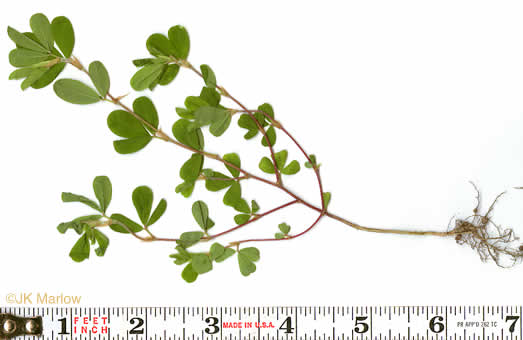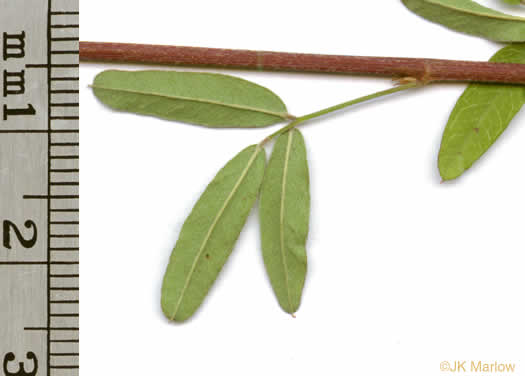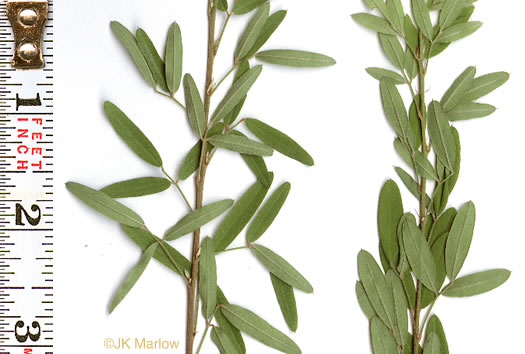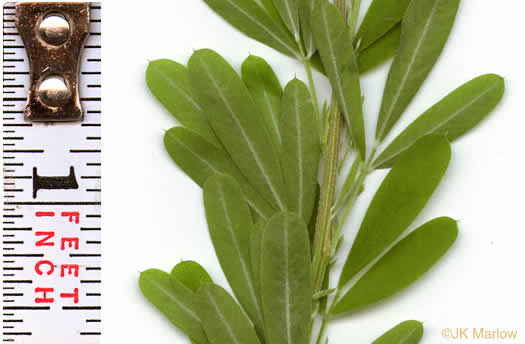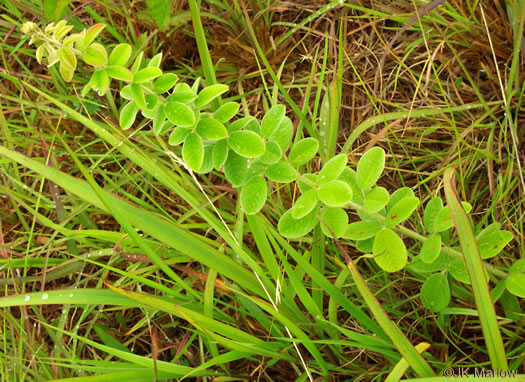Your search found 306 image(s) illustrating the term "petiole." For a written explanation, click on "petiole" in the Glossary.
PAGE 1 PAGE 2 PAGE 3 PAGE 4 PAGE 5 PAGE 6
To see larger pictures, click or hover over the thumbnails.
To go to the plant's detail page, click its name.
 Spring-beauty,
Claytonia virginica var. virginica
Spring-beauty,
Claytonia virginica var. virginica
Leaves 3" long or more, narrow and long-tapering without an evident petiole, per Wildflowers of the Southern Mountains (Smith, 1998).
 Carolina Spring-beauty,
Claytonia caroliniana
Carolina Spring-beauty,
Claytonia caroliniana
Leaf blade 1.5-7cm x 1.5-3.5cm, clearly differentiated from the petiole, per Vascular Flora of the Carolinas (Radford, Ahles, & Bell, 1968).
 Common Chickweed,
Stellaria media
Common Chickweed,
Stellaria media
Upper leaves without petiole; lower leaves with sparsely hairy long petiole, per Weeds of Southern Turfgrasses (Murphy et al., 1992).
 Common Black Cohosh,
Actaea racemosa
Common Black Cohosh,
Actaea racemosa
Petiole of basal leaves terete, not grooved (or with an early shallow groove), per Weakley's Flora.
 Mountain Black Cohosh,
Actaea podocarpa
Mountain Black Cohosh,
Actaea podocarpa
Petiole of basal leaves with a deep, broad groove (ca. 1mm wide & deep), per Weakley's Flora.
 Early Meadowrue,
Thalictrum dioicum
Early Meadowrue,
Thalictrum dioicum
All leaves have long petioles; leaflets may have as many as 9 rounded lobes, per Wildflowers of the Southern Mountains (Smith, 1998).
 Fig Buttercup,
Ficaria verna ssp. ficariiformis
Fig Buttercup,
Ficaria verna ssp. ficariiformis
Anecdotal observation: Petioles stout, grooved, not round in cross-section.
 Fig Buttercup,
Ficaria verna ssp. calthifolia
Fig Buttercup,
Ficaria verna ssp. calthifolia
Leaves crowded at base with few on short stems; petioles to 10cm long, per Weakley's Flora.
 Thimbleweed,
Anemone virginiana var. virginiana
Thimbleweed,
Anemone virginiana var. virginiana
Basal & upper lvs similar, lateral lobes deeply incised, stem lvs petioled, per Wildflowers of Tennessee, the Ohio Valley, and the Southern Appalachians (Horn, Cathcart, Hemmerly, & Duhl, 2005).
 Moonseed,
Menispermum canadense
Moonseed,
Menispermum canadense
Leaves palmately veined, lobed or not, petiole attached inside lower margin, per Woody Plants of the Blue Ridge (Lance).
 Southern Magnolia,
Magnolia grandiflora
Southern Magnolia,
Magnolia grandiflora
Note brown pubescence on young twigs, buds, petioles, and leaf undersides. — Clemson Extension
 Camphortree,
Camphora officinarum
Camphortree,
Camphora officinarum
Leaves glabrous, long-petioled, spicy-aromatic when crushed, per Woody Plants of the Southeastern US: A Winter Guide (Lance, 2004).
 Cleome,
Tarenaya species 1
Cleome,
Tarenaya species 1
Leaves: stipular spines 1-3mm; petiole 2.5-7.5cm, glandular-pubescent, with scattered spines 1-3mm, per Flora of North America.
 Blue Ridge Bittercress,
Cardamine flagellifera +
Blue Ridge Bittercress,
Cardamine flagellifera +
Petiole not auriculate at the base;, per Weakley's Flora (2022).
 Hairy Bittercress,
Cardamine hirsuta
Hairy Bittercress,
Cardamine hirsuta
Many persistent basal leaves forming a rosette; stem bases & petioles hirsute, per Weakley's Flora.
 Dwarf Sundew,
Drosera brevifolia
Dwarf Sundew,
Drosera brevifolia
Leaves obovate to spatulate, cuneate, 7-16mm long including indistinct petiole, per Vascular Flora of the Carolinas (Radford, Ahles, & Bell, 1968).
 Water Sundew,
Drosera intermedia
Water Sundew,
Drosera intermedia
Petioles glabrous, per Weakley's Flora (2015).
 Water Sundew,
Drosera intermedia
Water Sundew,
Drosera intermedia
Leaf blades longer than wide, spatulate; petioles filiform, 2-6cm long, per Vascular Flora of the Carolinas (Radford, Ahles, & Bell, 1968).
 Pink Sundew,
Drosera capillaris
Pink Sundew,
Drosera capillaris
Leaves obovate to spatulate, petioles equal to or slightly longer than blades, per Vascular Flora of the Carolinas (Radford, Ahles, & Bell, 1968).
 Pink Sundew,
Drosera capillaris
Pink Sundew,
Drosera capillaris
Petioles not filiform, less than 2cm long, per Vascular Flora of the Carolinas (Radford, Ahles, & Bell, 1968).
 Roundleaf Gooseberry,
Ribes rotundifolium
Roundleaf Gooseberry,
Ribes rotundifolium
Internodes usually glabrous, nodal spines 3-8mm or absent. Petioles puberulent, per Vascular Flora of the Carolinas (Radford, Ahles, & Bell, 1968).
 Oakleaf Hydrangea,
Hydrangea quercifolia
Oakleaf Hydrangea,
Hydrangea quercifolia
Brown woolly pubescence on stems, buds, petioles, & veins on leaf undersides. — Clemson Extension
 Mapleleaf Alumroot,
Heuchera villosa
Mapleleaf Alumroot,
Heuchera villosa
Petioles rusty-villous to glabrate, per Vascular Flora of the Carolinas (Radford, Ahles, & Bell, 1968).
 Brook-saxifrage,
Boykinia aconitifolia
Brook-saxifrage,
Boykinia aconitifolia
Basal leaves long-petioled, sharply divided into 5-7 toothed lobes; stem lvs similar but smaller, per Wildflowers of the Atlantic Southeast (Cotterman, Waitt, & Weakley, 2019).
 Brook Lettuce,
Micranthes micranthidifolia
Brook Lettuce,
Micranthes micranthidifolia
Basal leaves oblanceolate to oblong, tapering to winged petiole, per Wildflowers of Tennessee (Carman, 2005).
 Carey's Saxifrage,
Micranthes careyana
Carey's Saxifrage,
Micranthes careyana
Leaves petiolate, the blade rather abruptly contracted to the petiole, per Weakley's Flora.
 Purple Flowering-raspberry,
Rubacer odoratum
Purple Flowering-raspberry,
Rubacer odoratum
Glandular hairs on twigs and petioles, per Woody Plants of the Blue Ridge (Lance).
 American Mountain-ash,
Sorbus americana
American Mountain-ash,
Sorbus americana
Leaflets opposite, more than 3x long as broad, margins toothed; red petiole, per Native Trees of the Southeast, An Identification Guide (Kirkman, Brown, & Leopold, 2007).
 Red Chokeberry,
Aronia arbutifolia
Red Chokeberry,
Aronia arbutifolia
Stipules persistent, adnate to petiole, narrowly triangular, margins glandular, per Flora of North America.
 Lance’s Hawthorn,
Crataegus lancei
Lance’s Hawthorn,
Crataegus lancei
Petioles in the Apricae series 8-20mm and distinctly black-glandular, per Haws: A Guide to Hawthorns of the Southeastern US (Lance, 2014).
 Downy Hawthorn,
Crataegus mollis var. mollis
Downy Hawthorn,
Crataegus mollis var. mollis
Softly hairy leaf undersides & petioles, esp in spring, are characteristic, per Haws: A Guide to Hawthorns of the Southeastern US (Lance, 2014).
 Woolly Hawthorn,
Crataegus mollis var. lanuginosa
Woolly Hawthorn,
Crataegus mollis var. lanuginosa
Petioles eglandular. Leaf blades persistently pubescent abaxially, per Haws: A Guide to Hawthorns of the Southeastern US (Lance, 2014).
 Downy Hawthorn,
Crataegus mollis var. mollis
Downy Hawthorn,
Crataegus mollis var. mollis
Leaf lower surface distinctly pubescent to tomentose; petiole tomentose when young. — Ron Lance
 Rome Hawthorn,
Crataegus aemula
Rome Hawthorn,
Crataegus aemula
Petioles mostly <1/3 length of blade. — Ron Lance
 Green Hawthorn,
Crataegus viridis
Green Hawthorn,
Crataegus viridis
Leaf shape variable, base wedge-shaped, petiole slender and partly winged, per Haws: A Guide to Hawthorns of the Southeastern US (Lance, 2014).
 Choke Cherry,
Prunus virginiana var. virginiana
Choke Cherry,
Prunus virginiana var. virginiana
Leaves finely and sharply toothed; petiole often glandular, per Woody Plants of the Blue Ridge (Lance).
 Mimosa,
Albizia julibrissin
Mimosa,
Albizia julibrissin
The base of the petiole is swollen. — Clemson Extension
 Eastern Redbud,
Cercis canadensis var. canadensis
Eastern Redbud,
Cercis canadensis var. canadensis
Petioles swollen at both ends, per Woody Plants of the Blue Ridge (Lance).
 Common Partridge-pea,
Chamaecrista fasciculata var. fasciculata
Common Partridge-pea,
Chamaecrista fasciculata var. fasciculata
A sessile, saucer-shaped gland near the middle of the petiole, per Vascular Flora of the Carolinas (Radford, Ahles, & Bell, 1968).
 Kentucky Yellowwood,
Cladrastis kentukea
Kentucky Yellowwood,
Cladrastis kentukea
Petioles are enlarged at base and summit, per Native Trees of the Southeast, An Identification Guide (Kirkman, Brown, & Leopold, 2007).
 Kentucky Yellowwood,
Cladrastis kentukea
Kentucky Yellowwood,
Cladrastis kentukea
Buds enclosed within hollow base of petiole, per Vascular Flora of the Carolinas (Radford, Ahles, & Bell, 1968).
 Narrow-pod White Wild Indigo,
Baptisia albescens
Narrow-pod White Wild Indigo,
Baptisia albescens
Leaves 3-foliolate; petioles 5-10(20)mm long, per Weakley's Flora.
 Arrowhead Rattlebox,
Crotalaria sagittalis
Arrowhead Rattlebox,
Crotalaria sagittalis
Leaves elliptical to lance-shaped, on short petioles, a winged double-tipped stipule at the base, per Wildflowers of the Atlantic Southeast (Cotterman, Waitt, & Weakley, 2019).
 Showy Rattlebox,
Crotalaria spectabilis
Showy Rattlebox,
Crotalaria spectabilis
Leaves have short petioles and are smooth above, densely hairy beneath, per Forest Plants of the Southeast and Their Wildlife Uses (Miller & Miller, 2005).
 Leadplant,
Amorpha herbacea var. herbacea
Leadplant,
Amorpha herbacea var. herbacea
Petiole usually shorter than the width of the lowermost leaflet, per Vascular Flora of the Carolinas (Radford, Ahles, & Bell, 1968).
 Mountain Indigo-bush,
Amorpha glabra
Mountain Indigo-bush,
Amorpha glabra
Petioles typically much exceeding the width of the lowest leaflet, per Vascular Flora of the Carolinas (Radford, Ahles, & Bell, 1968).
 False Indigo,
Amorpha fruticosa
False Indigo,
Amorpha fruticosa
Leaflets (7)9-23(31) per leaf; petiole usually > width of contiguous leaflets, per Weakley's Flora.
 Hoary Tick-trefoil,
Desmodium canescens
Hoary Tick-trefoil,
Desmodium canescens
Petiole much longer than stalk of terminal leaflet, per Wildflowers of the Eastern United States (Duncan & Duncan, 1999).
 Hairy Small-leaf Tick-trefoil,
Desmodium ciliare
Hairy Small-leaf Tick-trefoil,
Desmodium ciliare
Stem pilose but petioles well-developed ... D. ciliare x D. marilandicum?, per Native and Naturalized Leguminosae (Fabaceae) of the United States (Isely, 1998).
 Hairy Small-leaf Tick-trefoil,
Desmodium ciliare
Hairy Small-leaf Tick-trefoil,
Desmodium ciliare
Small blunt leaflets with petioles under 3/8", more or less soft-hairy, per Wildflowers of the Southern Mountains (Smith, 1998).
 Smooth Small-leaf Tick-trefoil,
Desmodium marilandicum
Smooth Small-leaf Tick-trefoil,
Desmodium marilandicum
Stem leaves quite small (like D. ciliare), but tend to be glabrous and have 3/4" petioles, per Vascular Plants of North Carolina.
 Smooth Small-leaf Tick-trefoil,
Desmodium marilandicum
Smooth Small-leaf Tick-trefoil,
Desmodium marilandicum
A smooth plant with long petioles, per Wildflowers of the Southern Mountains (Smith, 1998).
 Stiff Tick-trefoil,
Desmodium obtusum
Stiff Tick-trefoil,
Desmodium obtusum
Petioles of median leaves usually shorter than width of lateral leaflets, per Vascular Flora of the Carolinas (Radford, Ahles, & Bell, 1968).
 Stiff Tick-trefoil,
Desmodium obtusum
Stiff Tick-trefoil,
Desmodium obtusum
Stems and petioles densely uncinate-pubescent, per Vascular Flora of the Carolinas (Radford, Ahles, & Bell, 1968).
 Korean-clover,
Kummerowia stipulacea
Korean-clover,
Kummerowia stipulacea
Mid-stem leaves with petioles 4-10mm long; stems antrorsely appressed-strigose, per Weakley's Flora.
 Japanese-clover,
Kummerowia striata
Japanese-clover,
Kummerowia striata
Mid-stem leaves have petioles 1-2(-4)mm long, per Weakley's Flora.
 Virginia Lespedeza,
Lespedeza virginica
Virginia Lespedeza,
Lespedeza virginica
Leaflet base and apex both rounded. Petioles of mid-stem leaves ~ 10mm long, per Weakley's Flora.
 Virginia Lespedeza,
Lespedeza virginica
Virginia Lespedeza,
Lespedeza virginica
Leaves with long petioles, leaflets < 1/4" wide & about 4x as long, per Wildflowers of the Southern Mountains (Smith, 1998).
 Sericea Lespedeza,
Lespedeza cuneata
Sericea Lespedeza,
Lespedeza cuneata
Leaves often gray-green. Lower petioles 1-2.5cm, upper leaves sessile, per Forest Plants of the Southeast and Their Wildlife Uses (Miller & Miller, 2005).
 Hairy Bush-clover,
Lespedeza hirta +
Hairy Bush-clover,
Lespedeza hirta +
Petioles of middle leaves 1-1.5cm, those of upper leaves short to none, per Forest Plants of the Southeast and Their Wildlife Uses (Miller & Miller, 2005).

